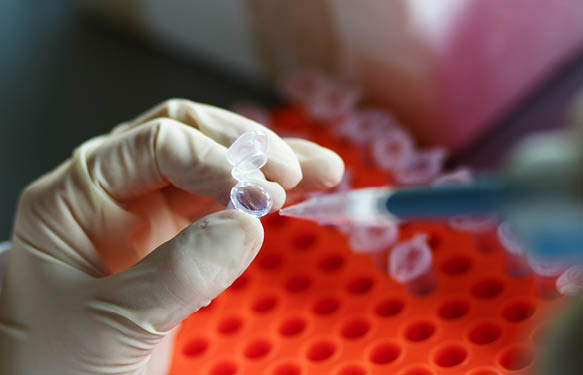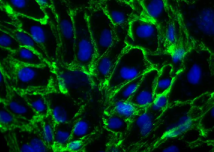When doing WBs, IFs or IHCs, we normally pay a lot of attention to the primary antibody that should be chosen. We look at the datasheet, we check that the primary antibody has been validated for the species and application of our interest, we check if it has been used in publications, we look at the pictures in the datasheet… but sometimes we forget about the secondary.
Here are some tips to help you choose the best secondary. Because a good choice of a secondary antibody can be as important as choosing the right primary! Thanks to Camilo Moncada, Ph.D., from Rockland Inc, for his support!
Tip #1 – Match the host species of the primary antibody
As obvious as it might seem, make sure that the secondary antibody recognises the species where the primary antibody has been made. Knowing the host species that was used to generate the primary antibody is easy, you can find this information in its datasheet. Remember, the species used to generate the secondary antibody should always be different from the host species of the primary antibody.

Finally, don’t forget what type of sample you are studying. If you are studying mouse samples, it might not be a good idea to use antibodies (primary or secondary) that recognise mouse. You may say… that’s obvious! Well, you’d be surprised…
Tip #2 – Select the correct reporter based on intended use
Identify the optimal secondary antibody required based on the detection assay. For techniques such as Western blot and ELISA, an enzyme conjugated secondary is the best choice. For immunoassays such as immunofluorescence microscopy or flow cytometry (FACS), it’s more typical to use a secondary antibody conjugated to a fluorochrome (i.e. DyLight™). For immunoprecipitation, a special reagent (e.g. TrueBlot®) that doesn’t detect the precipitating antibody is essential for publication quality images. For high-resolution microscopy, ATTO™ Dyes are the secondaries to choose.
Tip #3 – Consider using a pre-adsorbed secondary antibody

Pre-adsorption (also cross-adsorption) of the secondary antibody is used to eliminate reactivity from immunoglobulins of undesired species, antibody fragments and/or cell and tissue samples, improving the specificity of an antibody. The degree of cross reactivity is typically less than 1% of the desired signal. These highly cross-adsorbed antibodies show low levels of cross reactivity particularly required in multiple labeling experiments.
Tip #4 – Define the class / sub-class of the primary antibody
Primary polyclonal antibodies are generated in rabbit, goat, donkey, or chicken and are usually gamma chain immunoglobulins (IgG isotype). Therefore, the secondary antibody should be an anti-IgG antibody that recognizes both heavy and light chain of the primary antibody (anti-IgG H&L).
Primary monoclonal antibodies are normally raised in mouse, rat and Armenian hamster but even rabbit and human derived are also used. Because monoclonal IgG antibodies are subclass specific, it’s very important you use the secondary antibody directed against that specific subclass. Despite the notion that any anti-mouse IgG should recognize any of the IgG subclasses, recent studies have shown potential bias toward specific subclasses, making the use of anti-mouse IgG subclass-specific essential for “robust and reliable multiplex labeling of target proteins in a variety of applications”. When the sub-class of your primary antibody is unknown, you can use anti-IgG F(ab) or consider performing an isotyping assay.
Tip #5 – Sometimes smaller is better
F(ab’)2 fragment secondary antibodies are generated by pepsin digestion of whole IgG antibodies to remove most of the Fc region while leaving the hinge region intact. The resulting fragment is divalent with MW ~110 kDa.
Fab fragment secondary antibodies are generated by papain digestion of whole IgG antibodies to remove the Fc region entirely generating a monovalent antibody of ~50 kDa.
Both F(ab’)2 and Fab fragment antibodies eliminate non-specific binding to the Fc receptors on cells and penetrate tissues more efficiently due to their smaller size. When working with tissues or cells that have Fc receptors (spleen, peripheral blood, hematopoietic cells, leukocytes, NK cells etc.), choose a F(ab’)2 and Fab to eliminate non-specific binding to Fc receptors. Fragment conjugated secondary antibodies are ideal for Flow Cytometry, Immunohistochemistry and Immunofluorescence.
Tip #6 – Choose the purity level of the secondary antibody

Affinity purified antibodies are isolated by separating monospecific antibodies from other antiserum proteins and non-specific immunoglobulins by solid phase affinity chromatography. Advantages of using an affinity purified antibody include increased specificity, low background, greater sensitivity and lot-to-lot consistency. Affinity purification reduces variation from one product to another, leading to more reproducible immunoassays.
IgG fraction antibodies on the other hand are very robust and are prepared by a combination of salt fractionation and chromatographic methods with purity and specificity evaluated by different methods. The main benefit of using an IgG fraction is the presence of extremely high affinity antibodies that may result in a more potent secondary antibody reagent. This may or may not be the cause for affinity purified antibodies which usually exhibit improved specificity sometimes at the expense of affinity.
Low abundance proteins or weakly detected primary antibodies detected using an affinity purified secondary antibody may be better recognized using an IgG fraction secondary antibody. Assays where high background or non-specific binding from the secondary antibody are apparent may be optimized using an affinity purified secondary.
Interested in knowing more? Leave your questions or comments below, I’d be happy to offer suggestions to help you choose the right antibodies for your specific application.



